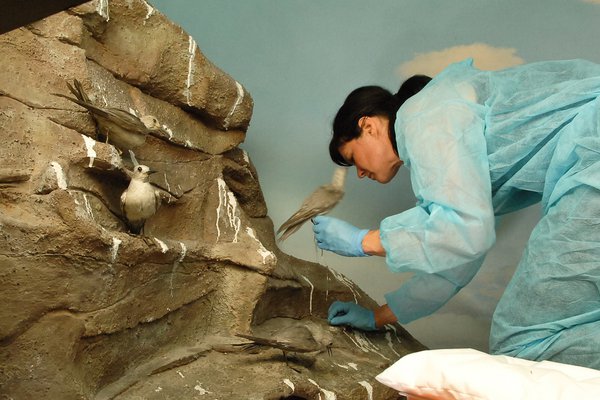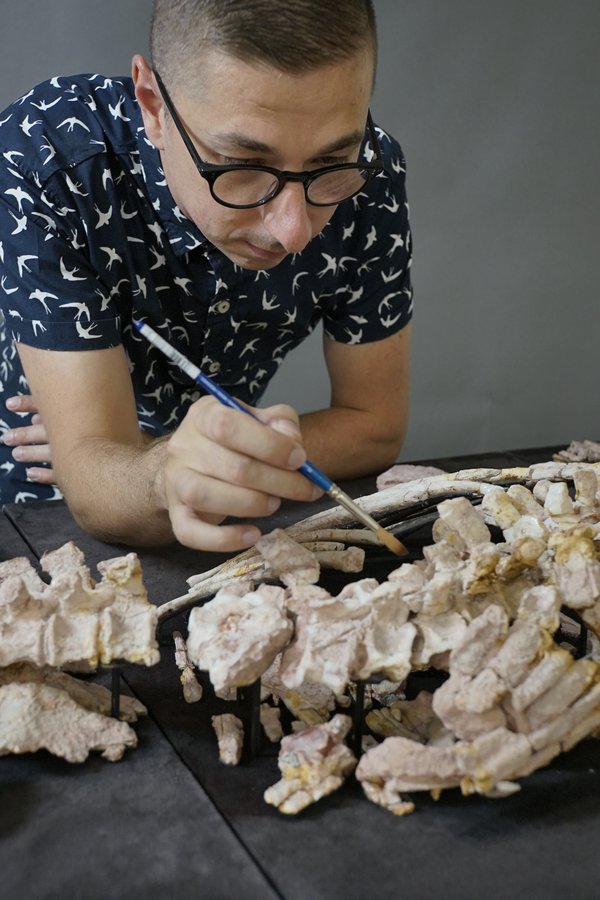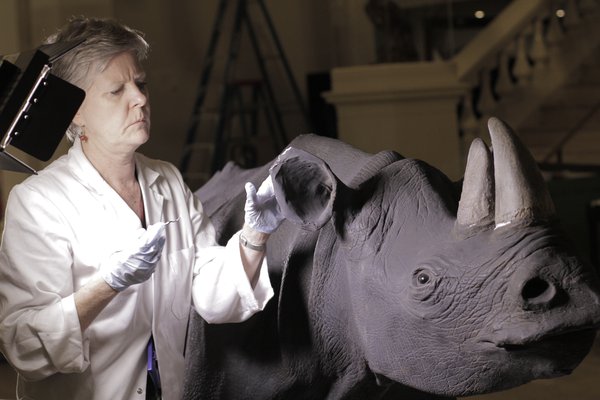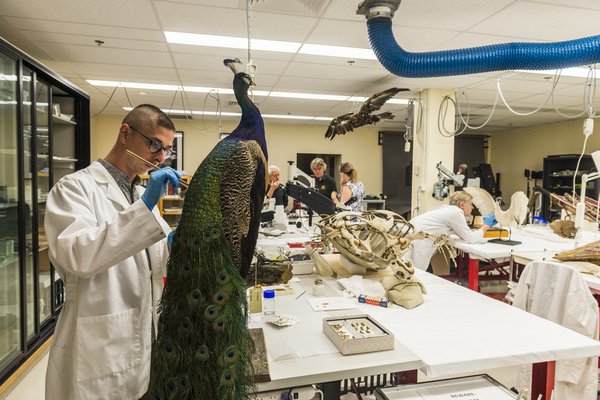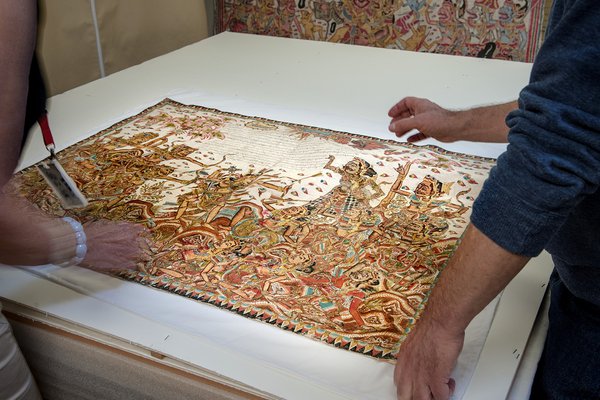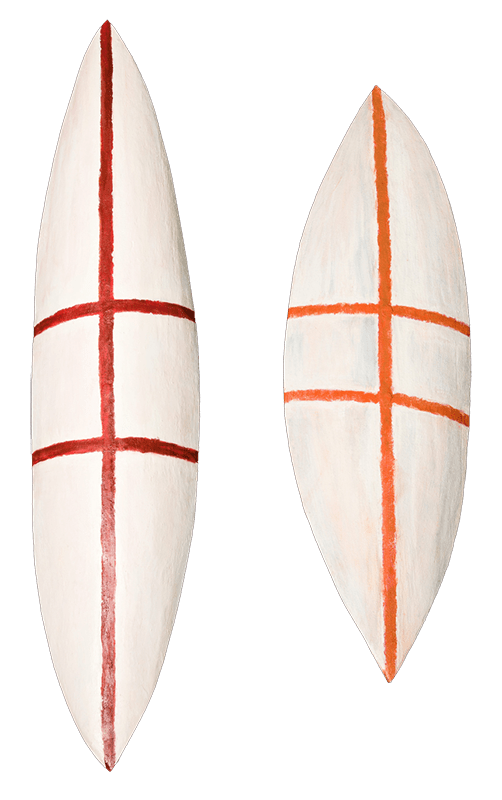Collection Care and Conservation
We specialise in the preservation of archaeological and cultural objects, rare books and archives, and biology and geology collections.

The Collection Care and Conservation unit includes staff members with skills outside of traditional conservation, such as taxidermy. Our work is divided into two major areas – preventive and treatment – to control deterioration of the Museum's collections, and to stabilise and/or improve the condition of significant individual objects.
Preventive conservation programs
- environmental monitoring and control
- pest control
- packing and transport of fragile objects
- disaster preparedness planning
- object handling
- improving storage systems
Treatment program
- remedial treatments as required
- preparation of objects for loan to other museums and cultural centres
- exhibitions at the Australian Museum
- larger scale complex treatments
Staff investigate new techniques and materials which will improve the preventive and treatment programs. The unit provides advice and training on preservation of cultural material for Australian Aboriginal communities and museums and cultural centres in South East Asia and the Pacific. Respect for communities' cultural property and ensuring the integrity of natural science specimens are always a key consideration in our decisions.
Conservation tips
Infestation by insect pests is one of the most common forms of damage to artefacts and specimens. Preventing access by insects and pests to collections/ objects/specimens is the primary method of preventing damage as well as regular checks for infestation.
Keeping artefacts in airtight plastic containers or zip lock bags is an effective method of storage and cost effective. Archival storage materials and systems are available from specialised suppliers and there are a range of options for all types of materials.
Checking for infestations
- It is useful to make regular inspections of storage areas to look for signs of insects.
- A powerful torch will help enormously in the inspection process to look for eaten areas and holes in objects, dead insects, insect droppings and insect frass (wood powder left by the insect).
- Check around the edges of rooms, in cupboards, under shelving, behind furniture and around and equipment and appliances that gives off warmth as these can harbour insects.
Blunder traps are very useful as they trap a sample of the insects that are active in the vicinity. The traps are simply a layer of adhesive on a card with a cardboard frame surrounding it. Traps can be purchased in supermarkets and hardware stores.
What to look for
Common insects such as cockroaches, moths and silverfish can attack feathers, seeds, wool, and silk. Evidence of insect attack can be found in the form of dropping fragments, dead insects, insect casings, and insect droppings (frass).
The most common insects to be found to infest materials are beetles, moths, and termites.
For further help
If you are concerned about an item in your home, you can reach out to amri@australian.museum or contact The Australian Institute for the Conservation of Cultural Materials (AICCM).
Mould can be very damaging to a wide range of objects. Mould grows on organic materials when the relative humidity remains above 65% for a prolonged period. It is disfiguring, can stain and obscure the surface, or even penetrate through the whole structure of an object.
To help prevent mould growth, you should try to keep your valuable objects in rooms with low relative humidity and good airflow. Mould growth is most likely to start in corners and in cupboards where there is little air movement. External wall surfaces in a room are also likely problem areas due to condensation of moisture on the colder surface and through rising dampness evaporating from the surface of the wall in some buildings. Mould can also grow on the back of paintings and textiles hanging on external walls due to the trapped moisture.
Mould growth may be reduced by ensuring good airflow during humid periods with fans and by opening cupboards. Equipment such as dehumidifiers that draw moisture out of the air can help in a room but only work effectively if the room is kept closed. Silica gel as a desiccant will work most effectively in an airtight container rather than an open room as the volume of air remains constant. This requires a great deal more than a small bowlful of silica in a wardrobe-sized space.
If mould growth does occur items should be removed to a well-ventilated area to dry out and decrease moisture levels. It is best not to try to remove the mould while it is still fresh. Once the item has dried, the dry mould can be brushed off the surface into a vacuum cleaner nozzle. A soft brush needs to be used to brush the spores into the vacuum. Please ensure your vacuum is cleaned afterwards and dispose of the vacuum bag.
It is recommended to wear a dust mask when dealing with mould growth.
For further help
If you are concerned about an item in your home, you can reach out to amri@australian.museum or contact The Australian Institute for the Conservation of Cultural Materials (AICCM).
Collection Care and Conservation stories
Conservation staff
Support our conservation work
The Australian Museum Foundation raises funds to support projects across the AM, from research and collections to cultural and education programs.
Donate now
